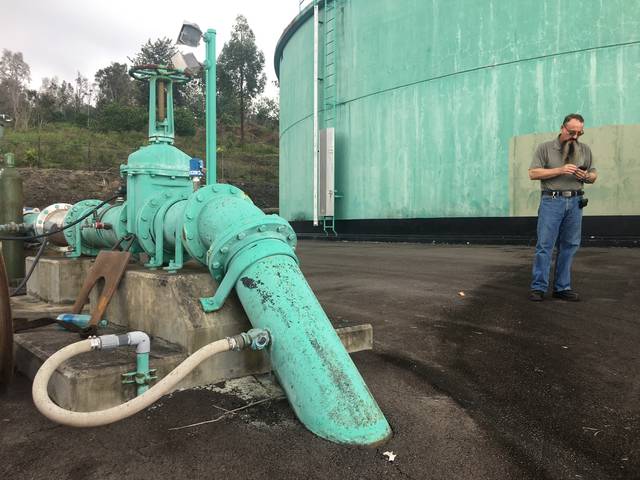Repairs to Honokohau deep well in North Kona could be sooner than later

KAILUA-KONA — The county Department of Water Supply has grappled with the question of why deep well failure has been so widespread and simultaneous throughout North Kona during the last year, a development that resulted in usage restrictions and sparked public concern and frustration.
ADVERTISING
DWS has yet to locate any concrete answers. However, as to the failure of the Honokohau deep well Sunday morning, which brought the number of inoperative wells in the 13-source system back up to five, the department might have found an immediate solution in its back pocket.
Keith Okamoto, DWS manager and chief engineer, said that while most deep well repairs take months, he’s hopeful the department can resolve this situation within a week.
The system’s saving grace might come in the form of a pump and motor intended for a repair at a deep well in Waimea.
“We postponed that project just in case something like this happened because we knew (the equipment) could also work at Honokohau,” Okamoto said.
The loss at Honokohau was particularly disconcerting because it serves as an anchor well to the already strained system. The deep well has a capacity of 2 million gallons and pumps 1,400 gallons per minute, but its importance extends beyond that.
Its location allows the well to pump water to accounts north and south throughout the system. Along with Honokohau, there are three other wells similarly situated that serve the same function — Keahuolu, Palani and Hualalai.
Deep wells at Palani and Hualalai are currently offline. They are scheduled to return to service by late October and late November, respectively.
“Even before Honokohau went down, Palani and Hualalai were really the high priorities,” Okamoto said. “We’re really trying to push to get them done ahead of time.”
Troubling repair histories
All three crucial deep wells — along with those at Keahuolu, which is functioning, and Waiaha, which is not — have been plagued by failing equipment that has deteriorated at a much faster rate than expected or previously observed.
The typical lifespan of deep well pumps and motors is 5-7 years, but Honokohau was last repaired in July 2015. And of the five wells in question, it has functioned the longest.
Palani went out of service last year, roughly 10 months after its most recent repair. Hualalai and Keahuolu faltered about six months after the installation of fresh parts.
And at Waiaha, equipment malfunctioned only days after being lowered into the well, prompting DWS to order it pulled back up. A cable subsequently snapped, sending the pump and motor plummeting the bottom of the well where they remain, likely damaged beyond use.
Okamoto said the pumps and motors for each of the wells have different horsepower levels and were made by different manufacturers, which puzzled DWS and rendered finding a common thread difficult.
A total of six wells failed in a 12-month span, a number representative of nearly half the North Kona system.
Disruptions
DWS on Sunday issued its most stringent water restriction mandates yet, telling customers in North Kona to limit usage to necessities only and asking them to halt all irrigation, as well as the washing of boats and vehicles. A press release Monday suggested customers store 5-10 gallons for use in case of a disruption.
The department is suspending water to all temporary service and irrigation accounts in the area. Agricultural and construction-based operations are still free to use water as necessary, within reason, to keep their businesses functional.
Okamoto remained optimistic Monday that disruptions can be avoided, noting Honokohau’s potentially speedy return to service and how the community cooperated the last time five wells were down at the beginning of July.
“This is still going to be our last resort,” Okamoto said.
If disruptions do come, there is one segment of users he said should brace for the hardest hit.
“Preliminary, we’re thinking the mauka areas will get affected first,” explained Okamoto, adding no specific subdivisions have been identified. “People furthest from the tanks as far as elevation will have water for the longest period of time because water will still be in the pipe even if it’s not in the tank.”
Potable water stores will be distributed to affected communities for basic use in the case of disruptions, and tank levels will be preserved to make sure enough resources are available to fight fires.
Okamoto explained whether it would be possible to supplement North Kona with water from any other system.
“The short answer is no,” he said.
Reaction
Mayor Harry Kim said Gov. David Ige reached out Monday morning offering to assist the county with whatever it might need. Most offerings from the public, however, have not been as generous.
“I understand the questions being asked in regards to competency of all of us, including me,” Kim said of criticism stemming from the protracted water crisis.
The mayor mandated DWS deliver him a daily report on the state of affairs in North Kona, adding water systems islandwide are likely to undergo an audit. But Kim is not considering a change in DWS management at this time.
“What is happening I don’t think could have been mitigated,” he said.
Affected residents mostly disagreed Monday on Facebook.
“The levels of incompetence regarding our critical infrastructure is shocking,” wrote Janna Lambert. “… Declare an emergency and bypass the lengthy nonsense.”
Bradley Peet seconded those comments.
“I don’t know how you can spin this any other way,” he wrote. “The county isn’t doing its job.”
Sentiments differed somewhat, however, as evidenced by a post from an account belonging to Annette and Ryan Reyes.
“Yes, we should’ve had backups for each well. Yes there’s mismanagement happening, BUT we also need people to stop taking water for granted,” the comment says. “… Water is more important than your lawn or your car. Help be part of the solution instead of just complaining about the management.”
Email Max Dible at mdible@westhawaiitoday.com.


